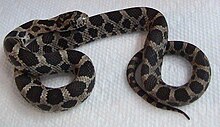Pantherophis gloydi
| Pantherophis gloydi | |
|---|---|
 |
|
| Juvenile | |
| Scientific classification | |
| Kingdom: | Animalia |
| Phylum: | Chordata |
| Subphylum: | Vertebrata |
| Class: | Reptilia |
| Order: | Squamata |
| Suborder: | Serpentes |
| Family: | Colubridae |
| Subfamily: | Colubrinae |
| Tribe: | Lampropeltini |
| Genus: | Pantherophis |
| Species: | P. gloydi |
| Binomial name | |
|
Pantherophis gloydi (Conant, 1940) |
|
| Synonyms | |
Pantherophis gloydi, commonly known as the eastern foxsnake or eastern fox snake, is a species of foxsnake. It is nonvenomous and can be found in the eastern Great Lakes region of the United States, as well as western Ontario in Canada.
The specific name, gloydi, is in honor of American herpetologist Howard K. Gloyd.
The eastern foxsnake is a North American ratsnake. It was recently split from its phylogenetically similar cousin the western foxsnake (Pantherophis vulpinus), of which it had been considered a subspecies, and now has full species recognition.
The eastern foxsnake prefers to live in marshes and other wetlands, as well as in the adjacent fields and meadows. They are found in the eastern Great Lakes region. Both species of foxsnake live in the state of Michigan. The western foxsnake lives in the Upper Peninsula, where it is known as the pine snake. The eastern foxsnake lives in the Lower Peninsula of Michigan. They can also be found in Ohio in the United States, and in Western Ontario in Canada. Historically, eastern foxsnake populations occurred in New York, but is now extirpated.
The eastern foxsnake is considered threatened over most of its range due to habitat loss. Numbers have plummeted because of the development of wetlands and coastal habitat. Their numbers have also fallen due to collection for the pet trade. The eastern foxsnake is often misidentified as the copperhead, Agkistrodon contortrix, due to their similar appearances, or as the eastern massasauga, Sistrurus catenatus, because they often rattle their tails similar to rattlesnakes as a form of mimicry. This also contributes to its decline in numbers, as many people fear that the snake may be venomous. In Ohio the eastern foxsnake is listed as a "Species of Concern" by the Ohio Division of Wildlife. In Michigan it is listed as a "Threatened Species" by the DNR and is protected by state law. In Ontario the species is listed as "Threatened Provincially and Nationally".
...
Wikipedia

